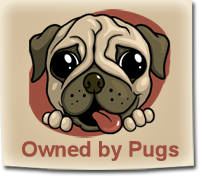Slimming down your pug
By Dr. Karen Hoffmann, DVM
July 19th, 2004
I recently rescued a pug that weighs close to thirty pounds. What is the best way to get my pug back in to shape?
Without question, the most common problem seen by veterinarians today is obesity. Many owners are not aware that their pet is overweight and that this is a serious health problem. A recent study* showed that lean dogs compared with overweight or obese dogs live an average of nearly 2 years longer! A veterinary examination and blood work, possibly including a thyroid profile (especially if previous weight loss attempts have failed) will help rule out medical problems. If all checks out, then the work begins. Ironically, weight management in our pets is relatively easy compared with ourselves. Humans, after all, have complete control over the diets of their pets.
It IS possible to achieve weight loss through diet and exercise. First, set a weight goal and a time frame for weight loss with the help of your veterinarian. [For example, your portly 30 pound pug may have an ideal body weight of 25 lbs. A reasonable rate of weight loss would be 2% per week (just over 1/2 lb per week). At this rate, it will take about 8 weeks to reach the goal.] Next, select a high quality diet and an appropriate volume of that diet. If staying with the same food, start feeding 25% less. This may be done gradually by reducing the volume a small amount at a time over 2 weeks, so the dog can become accustomed to less food. Eliminate high calorie snacks (such as Milk Bones) and replace with carrots or very small pieces of meat or cheese.
Lifestyle change is the second component to a weight loss program. Leash walking and swimming are great forms of exercise. Start with short distances and make it fun. Take your dog’s dinner along on walks and feed as treats for attentive behavior. Other activities may include play dates with a puppy or well-socialized adult dog and/or training/competing in dog sports such as obedience, agility, fly-ball or frisbee. Be sure your dogs checks out physically with your veterinarian, as some of these activities can be quite demanding.
It takes determination and sometimes tough love to achieve weight loss in our pets, especially those that have gained the excess weight in our care. For your newly adopted pug, the challenge should be easily met with diet and lifestyle adjustment. The result will be a healthier happier dog that may have a longer life.
* Effects of Diet Restriction on Life Span and Age-Related Changes in Dogs J Am Vet Med Assoc 220[9]:1315-1320 May 1'02 Feeding Study 20 Refs Richard D. Kealy, PhD; Dennis F. Lawler, DVM; Joan M. Ballam, MS; Sandra L. Mantz; Darryl N. Biery, DVM, DACVR; Elizabeth H. Greeley, PhD; George Lust, PhD; Mariangela Segre, DSc; Gail K. Smith, DVM, PhD, DACVS; Howard D. Stowe, DVM, PhD
